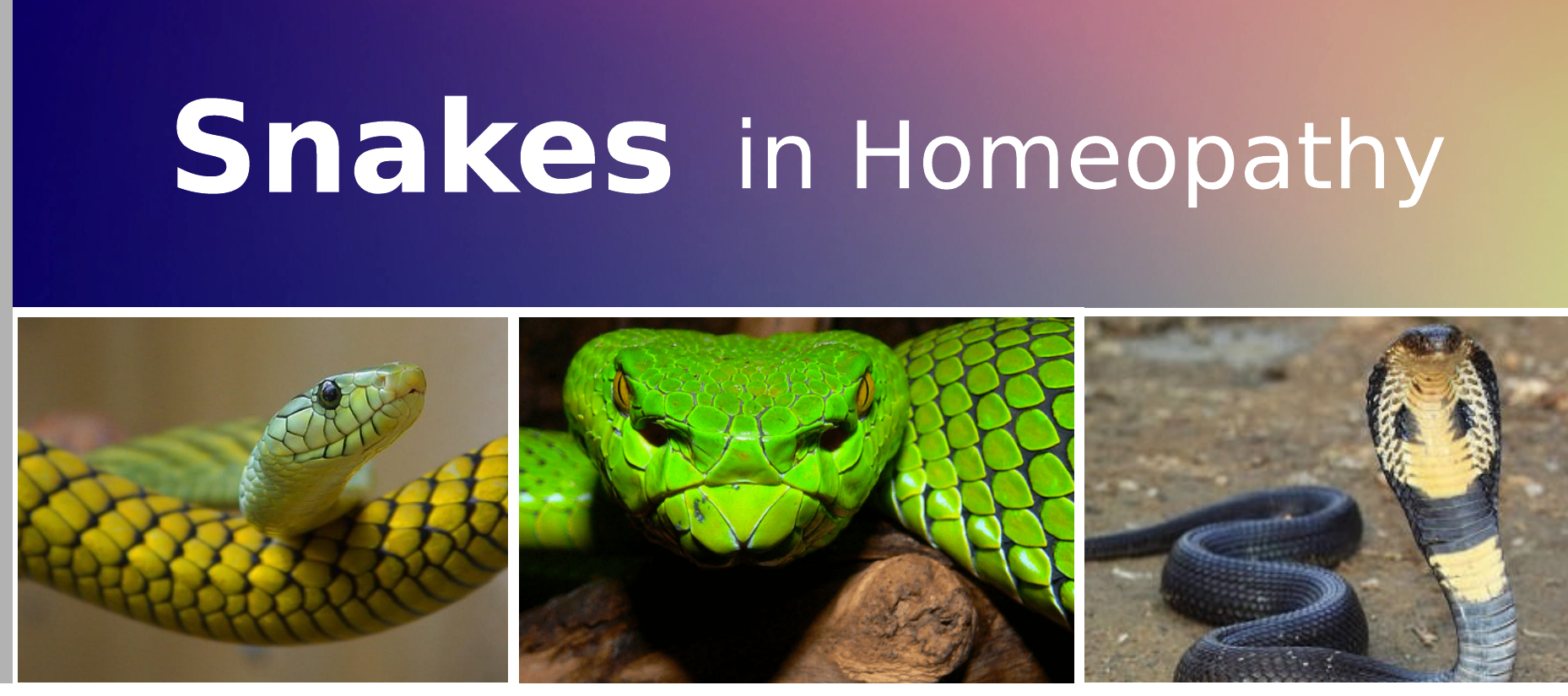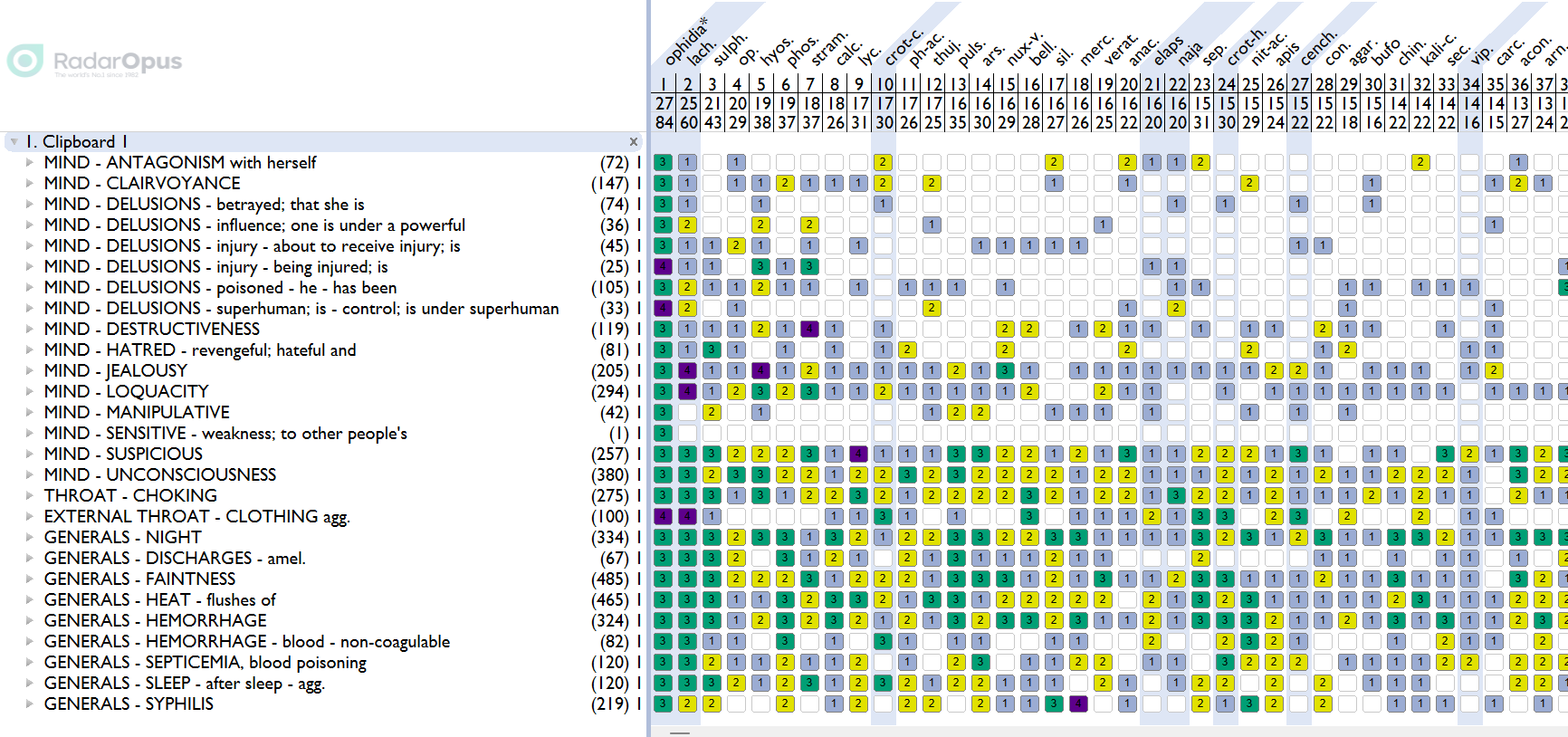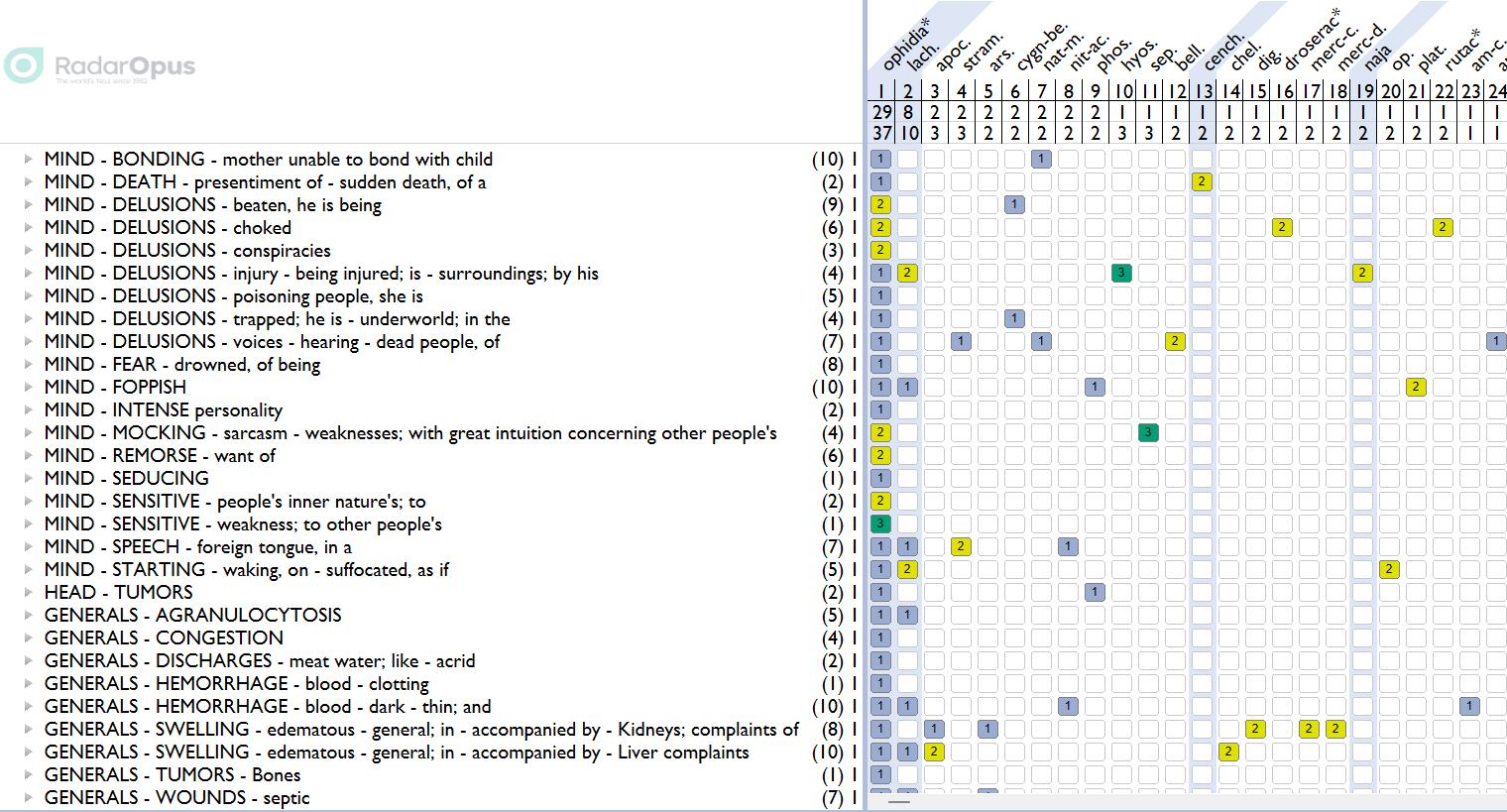The homeopathic system of medicine encompasses a wide range of remedies derived from various sources, including plants, minerals, and animals. Among the animal kingdom, snakes hold a noteworthy place due to their unique characteristics, venomous nature, and cultural significance.
This blog article delves into the homeopathic themes associated with the snake family, exploring natural science, taxonomy, toxicology, mythology, theology, doctrine of signatures, and keynote symptoms of 5 of the main snake remedies.


In the image above, you can see at a glance the Bold / underlined symptoms from Synthesis Adonis of the snake group (using the latin name Ophidia)
Natural Science, Taxonomy, and Toxicology
Natural science: The scientific study of snakes encompasses various fields, including herpetology, toxicology, and pharmacology. These disciplines help us understand the biological and physiological aspects of snakes, their venom composition, and potential therapeutic applications.
Taxonomy: The snake family, scientifically known as Serpentes, comprises numerous species classified into different genera and families. Each genus possesses unique characteristics and venom composition.
Physiological adaptations: Snakes possess unique physiological adaptations that enable them to thrive in diverse environments. For instance, their elongated bodies and lack of limbs allow for efficient locomotion, aided by their specialized scales and muscular structure.
Toxicology: Snake venoms are complex mixtures of proteins and peptides that vary in composition, potency, and effects. They serve various purposes such as prey immobilization and defense mechanisms. Understanding venom toxicology helps identify potential healing properties within the homeopathic context.
Venom composition: The venom of different snake species varies in its composition and effects. For example, some snakes, like the pit vipers, have venom that contains enzymes that break down tissues, leading to local tissue damage. Others, such as the elapids, have neurotoxic venom that affects the nervous system, causing paralysis and respiratory distress.
Venomous apparatus: Snakes have specialized venom delivery mechanisms, such as hollow fangs or grooved teeth, through which they inject venom into their prey or potential threats. The size, shape, and position of the fangs vary among different snake species, reflecting their unique hunting strategies and venom delivery methods.
Antivenom research: The study of snake venoms and their effects has led to advancements in antivenom production. Scientists analyze venom components to develop antivenoms that can neutralize the toxic effects of snake bites, potentially saving lives in regions where snakebite incidents are common.
Below are examples of how the venoms from three different snake species manifest at a physiological level within the human organism:
- Cobra (Naja genus)
- Neurotoxic effects: Cobra venoms contain neurotoxins that target the nervous system. When injected into the body, these neurotoxins can interfere with neurotransmitters, leading to paralysis, respiratory distress, and potentially fatal consequences.
- Cardiovascular effects: Some cobra venoms also have cardiotoxic components that can affect the cardiovascular system. They may cause disturbances in heart rhythm, decreased blood pressure, and even cardiac arrest.
- Rattlesnake (Crotalus genus)
- Hemotoxic effects: Rattlesnake venoms predominantly possess hemotoxic components that affect the blood and circulatory system. They can lead to the breakdown of red blood cells, causing anemia, blood clotting abnormalities, and tissue damage at the site of the bite.
- Local tissue necrosis: Certain rattlesnake venoms have enzymes that break down tissues, leading to localized necrosis around the bite area. This can result in significant tissue damage, swelling, and delayed healing.
- Viper (Bothrops genus)
- Hemorrhagic effects: Viper venoms often contain toxins that cause hemorrhaging by damaging blood vessels and interfering with blood clotting mechanisms. This can result in internal bleeding, bruising, and prolonged bleeding from wounds.
- Local and systemic effects: Viper venoms can cause both local and systemic effects. Locally, they may induce severe pain, swelling, and tissue damage. Systemically, they can lead to disturbances in blood pressure, kidney function, and coagulation processes.
It is important to note that these examples highlight the potential effects of snake venoms within the human organism. However, in the context of homeopathy, snake venoms are highly diluted and potentized to harness their potential healing properties while minimizing toxicity.
Prominent Snakes in Mythology and Theology
Mythological significance: Snakes have played prominent roles in various mythologies, symbolizing both divine and malevolent forces. For instance, in Greek mythology, the serpent symbolizes healing and wisdom through the Caduceus of Hermes. In Hindu mythology, the serpent represents transformation and eternity through Lord Shiva's adornment.
Theological associations: Snakes are often mentioned in religious texts and symbolize different concepts. In Christianity, the snake is associated with temptation and evil, referring to the serpent in the Garden of Eden. In other belief systems, snakes represent fertility, rebirth, and spiritual awakening.

In the above image, you can see the small (characteristic) rubrics from Synthesis Adonis which reflect the Homeopathic snake motifs or patterns
Grouped Genius Symptoms, Affinities, Modalities, and Keynotes
Genius symptoms: Symptoms common to the snake family include trembling, intense fears and phobias, sudden onset of symptoms, sensitivity to touch, coldness, and hypersensitivity.
Affinities: Snakes often show affinities for the nervous system, skin, blood, and cardiovascular system, manifesting symptoms such as neuralgia, skin disorders, hemorrhages, and circulatory disturbances.
Modalities: Symptoms may worsen with touch, cold weather, and during sleep, while improvement may occur with warmth, movement, and rest.
Keynotes: Key symptoms associated with snake remedies include fear of snakes, aggression, restlessness, paranoia, and intense anxiety.
Doctrine of Signatures in snake remedies
Parallels with human expressions: According to the doctrine of signatures, the external characteristics and behaviors of organisms reflect their internal therapeutic potential. By applying this concept, one can draw parallels between ophidian behavioral patterns and human conditions or mindsets.
Observing snakes in their natural habitats reveals specific behavioral patterns, such as shedding their skin, coiling, striking, and camouflage. These behaviors can be metaphorically interpreted and correlated with human experiences, emotions, and physiological processes.
Snake patients display intriguing behavioral patterns reminiscent of the survival habits and evolutionary attributes of snakes themselves. They may exhibit a remarkable ability to adapt and thrive in various environments, often displaying a calm and patient demeanor while meticulously observing their surroundings. Snake patients possess a heightened sense of self-preservation and an instinctual ability to assess potential threats and opportunities. Using their keen senses to detect vibrations and subtle changes in their environment, Snake patients seems attuned to the nuances of human interactions, often perceiving underlying motivations and hidden intentions.
Furthermore, like snakes shedding their skin to facilitate growth and renewal, these patients exhibit a remarkable capacity for personal transformation. They have embraced change as an integral part of their existence, shedding old beliefs and habits that no longer serve them and embracing new perspectives and approaches to life.
In terms of survival habits, Snake patients demonstrate an exceptional ability to patiently wait for the opportune moment to strike, much like a snake coiled and ready to strike its prey. This measured approach enables Snake patients to navigate challenges with calculated precision, harnessing their resourcefulness and adaptability to overcome obstacles.
Additionally, their introspective nature reflects the reptilian class's solitary tendencies. Like many snakes, they value moments of solitude and introspection, finding solace in self-reflection and deep contemplation. This reflective quality contributes to their wisdom and discernment, as they carefully evaluate situations before making decisions or taking action.
In summary, Snake patients exemplify heightened senses, self-preservation, patience, personal transformation, and a reflective nature.
When faced with conflict (an overarching theme of the animal kingdom), Snake patients may exhibit the following traits:
Calculated Observation: Just as snakes assess their environment and potential threats before taking action, Snake patients adopts a similar approach. They carefully observe the conflict situation, meticulously analyzing the dynamics, motivations, and underlying factors involved. This calculated observation allows Snake patients to gain a comprehensive understanding of the conflict and formulate an effective strategy.
Patient Timing: Snakes are known for their patient timing when it comes to striking their prey. Similarly, Snake patients exercise patience during conflicts, biding their time and waiting for the opportune moment to act. They understand that rushing into a conflict without proper timing and preparation may yield unfavorable outcomes. Instead, Snake patients strategically plan their actions, ensuring that they maximize their chances of success.
Swift and Targeted Response: Snakes possess remarkable agility and speed when they strike their prey. In a conflict situation, Snake patients demonstrate a similar ability to swiftly respond with focused precision. They capitalize on their keen observation and timing, delivering a well-directed and purposeful response that addresses the core issues at hand.
Defensive Manoeuvres: Snakes employ defensive manoeuvres to protect themselves when confronted with threats. Likewise, Snake patients utilize defensive strategies during conflicts to safeguard their interests and well-being. They may employ verbal or non-verbal communication techniques to assert their boundaries, stridently expressing their perspective while remaining mindful of the potential escalation of the conflict.
Strategic Retreat: Just as some snakes opt for a strategic retreat when faced with overwhelming threats, Snake patients recognize the value of stepping back from a conflict when necessary. They understand that not all conflicts can be resolved immediately or in their favor. In such instances, Snake patients tactfully disengage from the conflict, seeking opportunities to regroup, reassess, and approach the situation from a different perspective when the timing is more favorable.
Redline symptoms from the MIND and GENERALITIES chapters for 5 key snake remedies
Lachesis muta
MIND
- Loquacity (talkativeness).
- Jealousy and suspicion.
- Delusions of being persecuted or controlled.
- Heightened sensitivity to injustice and cannot bear contradiction.
GENERALITIES
- Left-sided symptoms predominate.
- Sensation of constriction or tightness, especially around the throat and chest.
- Aggravation from pressure or tight clothing.
- Symptoms worsen after sleep.
Crotalus horridus
MIND
- Delirium with incoherent speech.
- Extreme restlessness and anxiety.
- Suicidal thoughts and tendencies.
- Profound depression with a desire for solitude.
GENERALITIES
- Hemorrhagic tendencies with bleeding from various orifices.
- Rapid disintegration of vitality.
- Septic conditions with a foul odor.
- Weakness and prostration, as if dying.
Naja tripudians
MIND
- Anxiety and fear of death.
- Extreme sensitivity and emotional intensity.
- Restlessness with a constant feeling of impending doom.
- Difficulty concentrating and memory problems.
GENERALITIES
- Sensation of constriction or tightness around the heart.
- Palpitations and irregular heartbeat.
- Aggravation from warm temperatures and exertion.
- Symptoms improve with open air and cold applications.
Cenchris contortrix
MIND
- Sudden mood swings and irritability.
- Hypersensitivity to noise and touch.
- Fearfulness and aversion to being alone.
- Difficulty focusing and forgetfulness.
GENERALITIES
- Swelling and discoloration at the site of bites or injuries.
- Trembling and twitching of muscles.
- Aggravation from motion and touch.
- Symptoms improve with cold applications.
Bothrops lanceolatus
MIND
- Restlessness and agitation.
- Emotional volatility and irritability.
- Difficulty concentrating and forgetfulness.
- Fear of being poisoned or contaminated.
GENERALITIES
- Hemorrhagic tendencies with bleeding from various orifices.
- Ecchymosis (bruising) and swelling.
- Aggravation from heat and warm weather.
- Symptoms worsen during the night.
It's important to note that the list provided is a brief summary and not an exhaustive representation of the remedies. Professional guidance from a qualified homeopath is recommended for a comprehensive understanding and accurate prescription of these remedies.
In conclusion, the homeopathic themes surrounding the snake family incorporate various aspects of natural science, taxonomy, toxicology, mythology, and the doctrine of signatures. Through an exploration of these themes, it becomes evident that snakes hold a profound significance in the homeopathic context, both as physical entities and as archetypal symbols. By understanding and applying these themes, homeopathic practitioners can identify potential remedies for addressing human health concerns rooted in snake-like characteristics, opening new avenues for healing and well-being.
